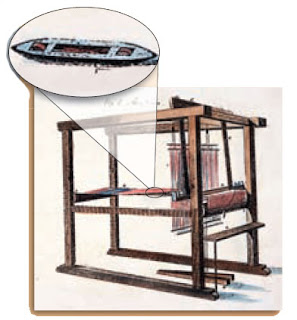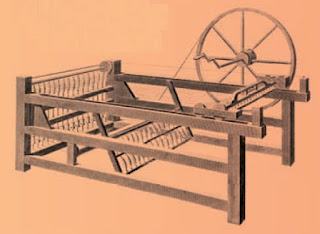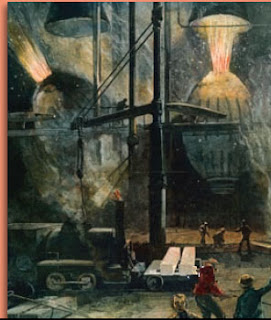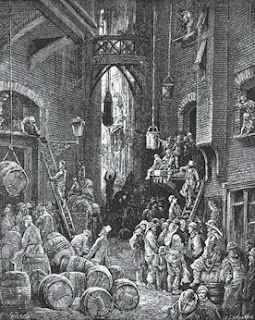The Industrial Revolution
New Machines and
Methods
In the 1700s and
1800s new inventions completely changed the way people worked. At
the same time, scientific discoveries led to key advances in health.
|
การปฏิวัติอุตสาหกรรม
เครื่องจักรใหม่กับวิธีการใหม่
ในคริสต์ศตวรรษที่ 1700 และ
1800 สิ่งประดิษฐ์ใหม่ ๆ ได้เปลี่ยนแปลงแนวทางที่คนทำงานได้อย่างสมบูรณ์
ในเวลาเดียวกัน การค้นพบทางวิทยาศาสตร์นำไปสู่ความก้าวหน้าทางด้านสุขภาพ
|
|
New Inventions
Starting in the early
1700s a series of new inventions completely changed the way goods were made. In this time, called the Industrial Revolution, machines in
factories began to perform the work that before had been done by hand at home
or in small shops. This period of industrialization began
in Great Britain but soon spread.
|
สิ่งประดิษฐ์ใหม่ ๆ
นับตั้งแต่ช่วงต้นคริสต์ศตวรรษที่
1700 เป็นต้นมา สิ่งประดิษฐ์ใหม่ ๆ ที่เกิดขึ้นมาตามลำดับ ได้เปลี่ยนแปลงแนวทางผลิตสินค้าอย่างสมบูรณ์แบบ
ในยุคนี้ เรียกว่า การปฏิวัติอุตสาหกรรม เครื่องจักรในโรงงานเริ่มทำงานซึ่งแต่ก่อนใช้มือทำที่บ้านหรือในร้านเล็ก
ๆ ช่วงเริ่มต้นอุตสาหกรรมนี้เริ่มขึ้นในสหราชอาณาจักร
แต่ไม่นานก็มีการแพร่กระจาย
|
|
The textile, or cloth-weaving, industry was the first to change. Inventions
like the flying shuttle, spinning jenny, and cotton gin combined to greatly
increase cotton production and speed up the weaving process. As
a result, Great Britain’s textile industry grew rapidly.
|
อุตสาหกรรมสิ่งทอหรืออุตสาหกรรมการทอผ้าเป็นอุตสาหกรรมแรกที่มีการเปลี่ยนแปลง
สิ่งประดิษฐ์คล้ายกับกระสวยบินได้ สปินนิงเจนนี (ชื่อเครื่องปั่นฝ้าย) และผ้าฝ้ายรวมเข้าด้วยกันเพื่อเพิ่มการผลิตฝ้ายและเพิ่มความเร็วในการทอผ้าได้มากมาย
ส่งผลให้อุตสาหกรรมสิ่งทอของอังกฤษเติบโตขึ้นอย่างรวดเร็ว
|
|
In 1769 James Watt
developed an efficient steam engine that could power the new factory machines. Since iron was used to make steam-powered
machines, demand for iron grew. In 1856 Henry Bessemer developed
a way to cheaply convert iron into steel. Because steel
was stronger than iron, the steel industry grew as well.
|
ในปี ค.ศ. 1769 (พ. ศ.
2312) เจมส์ วัตต์ ได้พัฒนาเครื่องยนต์ไอน้ำอันทรงประสิทธิภาพ ซึ่งสามารถขับเคลื่อนเครื่องจักรโรงงานแห่งใหม่ได้
เนื่องจากเหล็กถูกนำมาใช้เพื่อผลิตเครื่องจักรที่ใช้ไอน้ำเป็นแรงขับเคลื่อน ความต้องการเหล็กจึงเพิ่มมากขึ้น
ในปี ค.ศ. 1856 (พ.ศ. 2399) เฮนรี เบสเซเมอร์ ได้พัฒนาวิธีการทำแร่เหล็กให้กลายเป็นเหล็กกล้าอย่างรวดเร็ว
เนื่องจากเหล็กกล้ามีความแข็งแรงกว่าแร่เหล็ก อุตสาหกรรมเหล็กจึงขยายตัวได้ดี
|
|
New inventions also
improved transportation and communication. Steamships made
river travel faster. Steam-powered trains
replaced slow animal-drawn carts. In
addition, a new device called the telegraph made it possible to quickly send
messages over long distances.
|
สิ่งประดิษฐ์ใหม่ ๆ ช่วยปรับปรุงการคมนาคมและการสื่อสาร
เรือกลไฟทำให้การสัญจรทางแม่น้ำเร็วขึ้น รถไฟพลังไอน้ำได้เข้ามาแทนที่รถลากด้วยสัตว์เลี้ยงที่อืดอาดชักช้า
นอกจากนี้ อุปกรณ์ใหม่ที่เรียกว่า โทรเลข ก็ทำให้สามารถส่งข้อความได้อย่างรวดเร็วในระยะทางไกล
|
Key
Inventions, 1733–1856
|
สิ่งประดิษฐ์สำคัญ
ค.ศ. 1733 – 1856
(พ.ศ.
2276 – 2399)
|
|||
1733
Flying Shuttle
John Kay’s invention sped up weaving so much that weavers outpaced
their supply of thread.
|
ค.ค. 1733 (พ.ศ. 2276)
กี่กระตุกกระสวยบิน
เครื่องประดิษฐ์ของจอหน์
เคย์ ช่วยให้การทอผ้าเร็วขึ้นอย่างมากจนกระทั่งช่างทอผ้าจัดส่งด้ายได้อย่างรวดเร็ว
|
1764
Spinning Jenny
James Hargreaves’s invention made thread fast enough to keep up with the
flying shuttle.
|
ค.ศ. 1764 (พ.ศ. 2307)
สปินนิง เจนนี
เครื่องประดิษฐ์ของเจมส์
ฮาร์กรีฟส์ ประดิษฐ์ด้ายได้รวดเร็วเท่ากับกระสวยบิน
|
|
The Factory System
Before
industrialization, each good had been individually made by hand.
We can imagine what a slow process this was. Industrialization
shifted production to a factory system. In the factory
system, machines rapidly produce large quantities of goods at factories.
|
ระบบโรงงาน
ก่อนการพัฒนาอุตสาหกรรม
สินค้าแต่ละอย่างใช้มือทำ เราสามารถจินตนาการได้ว่ากระบวนการนี้ชักช้าขนาดไหน การพัฒนาอุตสาหกรรมได้เปลี่ยนแปลงการผลิตไปเป็นระบบโรงงาน
ในระบบโรงงาน เครื่องจักรผลิตสินค้าปริมาณมากได้อย่างรวดเร็วในโรงงาน
|
|
Advances in
transportation improved the efficiency of the factory system. Trains
and steamships could bring raw materials to the factories and carry finished
goods away. Products could then be shipped quickly to
faraway markets.
|
ความก้าวหน้าในการขนส่ง
ได้ปรับปรุงประสิทธิภาพของระบบโรงงาน รถไฟและเรือกลไฟ สามารถนำวัตถุดิบไปยังโรงงานและนำสินค้าและผลิตเสร็จแล้วออกจากโรงงาน
ครั้นแล้ว ผลิตภัณฑ์ก็สามารถจัดส่งไปยังตลาดที่อยู่ห่างไกลได้อย่างรวดเร็ว
|
|
The new industries
that sprang up during this period needed money to operate. Bankers,
merchants, and rich landowners provided capital, money to invest in
activities that produce more money. Because they, not
the government, were funding industrialization, capitalists wanted government
to stay out of business matters. They wanted laissez-faire, a “let things be” attitude on the part of government toward industry. Governments agreed and placed very few regulations on
business.
|
อุตสาหกรรมใหม่ที่ผุดขึ้นมาในช่วงเวลานี้จำเป็นต้องใช้เงินเพื่อดำเนินการ
นายธนาคาร พ่อค้าและเจ้าของที่ดินผู้ร่ำรวย ได้จัดสรรเงินทุนเพื่อการลงทุนในกิจกรรมที่สร้างรายได้มากขึ้น
เนื่องจากพวกที่ไม่ใช่รัฐบาลกำลังระดมทุนให้กับอุตสาหกรรม เหล่านักลงทุนต้องการให้รัฐบาลอยู่ห่าง
ๆ จากเรื่องทางธุรกิจ พวกเขาต้องการระบบเศรษฐกิจแบบเสรีนิยม, ทัศนคติว่า
"ปล่อยให้ทุกสิ่งเป็นไป" ในส่วนของรัฐบาลที่มีต่ออุตสาหกรรม
รัฐบาลได้ตกลงและวางระเบียบข้อบังคับเกี่ยวกับธุรกิจไม่มากนัก
|
|
Industrialization
spread to the United States by the early 1800s. By the
century’s end industrialization had spread to a number of
countries in western Europe.
|
การพัฒนาอุตสาหกรรมได้แพร่กระจายไปยังประเทศสหรัฐอเมริกา
ประมาณต้นศตวรรษที่ 1800 ประมาณตอนปลายศตวรรษที่ 20
อุตสาหกรรมได้แพร่กระจายไปยังหลายประเทศในยุโรปตะวันตก
|
|
Scientific Advances
The Industrial Age
was also a time of increased scientific research. In
medicine, Edward Jenner developed a treatment to prevent smallpox—one of the deadliest diseases of the time. Louis
Pasteur discovered that germs cause disease, and he developed ways to kill
them. These discoveries improved the health of millions
and saved many lives.
|
ความก้าวหน้าทางวิทยาศาสตร์
ยุคอุตสาหกรรมยังเป็นช่วงเวลาของการวิจัยทางวิทยาศาสตร์ที่เพิ่มขึ้นด้วย
ในทางการแพทย์ เอ็ดเวิร์ด เจนเนอร์ ได้พัฒนาวิธีการรักษาเพื่อป้องกันไข้ทรพิษ ซึ่งเป็นโรคที่อันตรายที่สุดชนิดหนึ่งในเวลานั้น
หลุยส์ ปาสเตอร์ ได้ค้นพบว่าเชื้อโรคที่ทำให้เกิดโรคภัยไข้เจ็บและก็พัฒนาวิธีฆ่าพวกเชื้อโรคเหล่านั้น
การค้นพบเหล่านี้ช่วยให้สุขภาพของคนนับล้านดีขึ้นและช่วยชีวิตคนจำนวนมาก
|
|
In chemistry and
physics, scientists made important discoveries about the structure of atoms,
the small particles that make up everything in the universe. Major
breakthroughs were also made in the fields of geology and psychology, the
study of the mind.
|
ในด้านเคมีและฟิสิกส์ นักวิทยาศาสตร์ได้ค้นพบสิ่งสำคัญเกี่ยวกับโครงสร้างของอะตอม
อนุภาคขนาดเล็กที่สร้างทุกอย่างในจักรวาลขึ้นมา
การค้นพบครั้งสำคัญยังเกิดขึ้นในด้านธรณีวิทยาและจิตวิทยา ซึ่งเป็นการศึกษาจิตใจ
|
Key Inventions, 1733–1856
|
สิ่งประดิษฐ์สำคัญ
ค.ศ. 1733 – 1856
(พ.ศ. 2276 – 2399
|
|
1769
Steam Engine
First used in
factories, the steam engine later powered locomotives and ships.
|
ค.ศ. 1769 (พ.ศ. 2312)
เครื่องจักรไอน้ำ
เครื่องจักรไอน้ำ
ซึ่งมีใช้ครั้งแรกในโรงงาน ต่อมาก็ช่วยเป็นพลังขับเคลื่อนหัวรถจักรและเรือกำปั่น
|
|
Key
Inventions, 1733–1856
|
สิ่งประดิษฐ์สำคัญ
ค.ศ. 1733 – 1856
(พ.ศ.
2276 – 2399)
|
|||
1793
Cotton Gin
American Eli Whitney’s device cut the time U.S.
growers spent cleaning cotton, helping them keep up with British
demand.
.
|
ค.ศ. 1793 (พ.ศ. 2336)
คอตตอนจิน (เครื่องแยกเมล็ดฝ้ายออกจากเส้นใย)
อุปกรณ์ของชาวอเมริกันนามว่า
เอลี วิตนีย์ ช่วยย่นเวลาทำความสะอาดฝ้ายให้กับผู้ปลูกฝ้าย ช่วยให้ทันความต้องการของอังกฤษ
|
1856
Bessemer Furnace
The Bessemer furnace
made steel from molten iron.
|
ค.ศ. 1856 (พ.ศ. 2399)
เตาเบสเซเมอร์
เตาเบสเซเมอร์สร้างเหล็กกล้าจากเหล็กดิบที่หลอมแล้ว
|
|
A New Way of Life
The Industrial
Revolution changed the work experience and way of life for millions of people
in Europe and America.
|
วิถีชีวิตใหม่
การปฏิวัติอุตสาหกรรมได้เปลี่ยนแปลงประสบการณ์การทำงานและวิถีชีวิตของคนนับล้านในยุโรปและอเมริกา
|
|
The Workers
During the 1800s
machines began to do much of the work once done by weavers, artisans,
and farmworkers. As a result, many people had no way to
support themselves. Unemployed workers moved from farms
to the cities and took jobs in the new factories. As a
result, cities quickly grew.
|
คนทำงาน
ในช่วงศตวรรษที่ 1800
เครื่องจักรเริ่มทำงานที่ครั้งหนึ่งช่างทอผ้า ช่างฝีมือ
และคนงานในฟาร์มเคยทำได้จำนวนมาก เป็นผลให้หลายคนไม่มีทางที่จะสนับสนุนตัวเอง
แรงงานที่ไม่มีงานทำจึงได้ย้ายจากฟาร์มไปสู่เมืองและทำงานในโรงงานใหม่
เป็นผลให้เมืองเติบโตขึ้นอย่างรวดเร็ว
|
|
Factory workers faced
difficult conditions. Working long days on the machines was
tiring and dangerous. Wages were poor. Women
and children had to work too, but for lower pay than men.
|
คนงานโรงงานต้องเผชิญกับสภาวะที่ยากลำบาก
การทำงานบนเครื่องจักรเป็นเวลานานทำให้เหนื่อยล้าและเป็นอันตราย ค่าจ้างก็ต่ำ
ผู้หญิงและเด็กต้องทำงานด้วยเช่นกัน แต่ได้รับค่าใช้จ่ายต่ำกว่าผู้ชาย
|
|
In addition,
industrial cities were harsh places to live in. Factories
polluted the air. Housing was crowded and poorly built. Garbage filled the streets. Crime
became a part of daily life in many areas.
|
นอกจากนี้ เมืองอุตสาหกรรมยังเป็นสถานที่ยากลำบากในการอยู่อาศัยอีกด้วย
โรงงานทำให้อากาศเป็นมลพิษ ที่อยู่อาศัยหนาแน่นและสร้างไม่ดี ขยะเต็มถนน
อาชญากรรมได้กลายเป็นส่วนหนึ่งของชีวิตประจำวันในหลายพื้นที่
|
|
Because of these
problems, some reformers wanted to replace the capitalist system. In its place, they promoted socialism, a social system
in which businesses are either owned by the workers or controlled by the
government. Socialists hoped that ending private ownership
of industries would stop the poor treatment of workers. German
philosopher Karl Marx called for workers to unite in a revolution to
bring down the capitalist system.
|
เนื่องจากปัญหาเหล่านี้
นักปฏิรูปบางพวกจึงต้องการเปลี่ยนระบบทุนนิยม ในถิ่นกำเนิดของระบบนี้ คนเหล่านั้นได้ส่งเสริมสังคมนิยม
ซึ่งเป็นระบบสังคมที่มีแรงงานเป็นเจ้าของธุรกิจหรือไม่ก็รัฐบาลเข้ามาควบคุม นักสังคมนิยมหวังว่า
การยุติการยึดอุตสาหกรรมมาเป็นกรรมสิทธิ์ส่วนตัวจะยับยั้งการปฏิบัติที่ไม่ดีต่อแรงงาน
นักปรัชญาชาวเยอรมัน นามว่า คาร์ล มากซ์
เรียกร้องให้คนงานรวมตัวกันในการปฏิวัติเพื่อโค่นล้มระบบทุนนิยม
|
|
A Growing Middle
Class
Some people benefited
more than others from the changes of the 1800s. The
middle class grew to include factory managers, merchants, clerks, engineers,
doctors, and other well-educated professionals. People in the middle class earned good incomes and could
afford comfortable lives.
|
ชนชั้นกลางเพิ่มขึ้น
บางคนได้รับประโยชน์มากกว่าคนอื่น
ๆ จากการเปลี่ยนแปลงแห่งศตวรรษที่ 1800 ชนชั้นกลางรวมถึงผู้จัดการโรงงาน
พ่อค้า เสมียน วิศวกร หมอและผู้เชี่ยวชาญด้านการศึกษาที่มีชื่อเสียงอื่น ๆ ผู้คนในชนชั้นกลางมีรายได้ดีและสามารถมีชีวิตที่สะดวกสบายได้
|
|
The middle and upper
classes also had time to read, visit museums, and attend plays and concerts. Two major trends in the arts competed for their attention. Romanticism stressed beauty, nature, emotions, and simpler
times. Realism tried to show everyday life as it really
was.
|
ชั้นกลางและชั้นสูงยังคงมีเวลาอ่านหนังสือ
ไปเยี่ยมชมพิพิธภัณฑ์และฟังบทละครและคอนเสิร์ต แนวโน้มสำคัญสองอย่างในศิลปะแข่งขันกันดึงดูความสนใจของพวกเขา
จินตนิยมเน้นความงาม ธรรมชาติ ความรู้สึกและเวลาที่เรียบง่าย สัจนิยมพยายามแสดงการดำเนินชีวิตประจำวันตามความเป็นจริง
|
|
Romanticism
and Realism
|
|
ศิลปะจินตนิยมกับศิลปะสัจนิยม
|
|
|
|
|
|
During the 1800s two
major artistic movements emerged: romanticism and
realism. Romantic artists rebelled against the changes
brought by the Industrial Revolution. They focused on
beauty and nature and tried to show life as they thought it should be. Realists, on the other hand, attempted to show life as it actually
was. They often dealt with the social and economic
effects of the Industrial Revolution.
|
|
ในช่วงปี คริสต์ศตวรรษที่
1800 มีขบวนการเคลื่อนไหวทางศิลปะที่สำคัญเกิดขึ้นสองขบวนการ คือ ศิลปะจินตนิยมกับศิลปะสัจนิยม
เหล่าศิลปินแนวจินตนิยมต่อต้านการเปลี่ยนแปลงที่เกิดจากการปฏิวัติอุตสาหกรรม
พวกเขามุ่งเน้นความสวยงามและธรรมชาติและพยายามแสดงออกถึงชีวิตตามที่พวกเขาคิดว่ามันควรจะเป็น
ในทางกลับกัน เหล่าศิลปินสัจนิยมพยายามจะแสดงให้เห็นถึงความเป็นจริง พวกเขามักจะมีปฏิกิริยากับผลกระทบของการปฏิวัติอุตสาหกรรมที่มีต่อสังคมและเศรษฐกิจ
|







